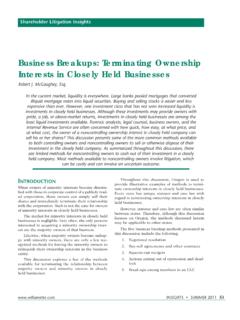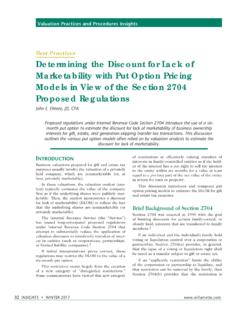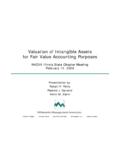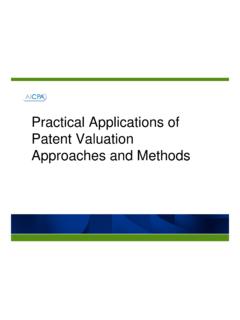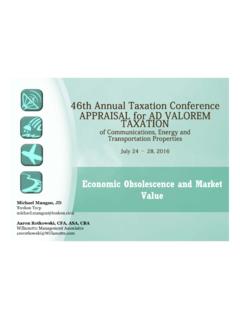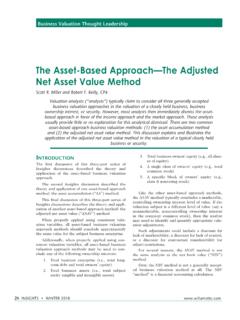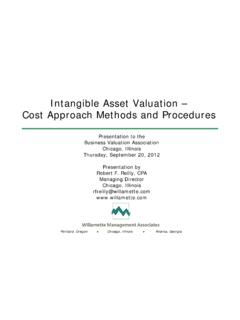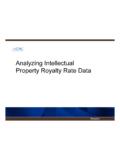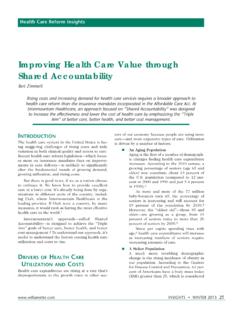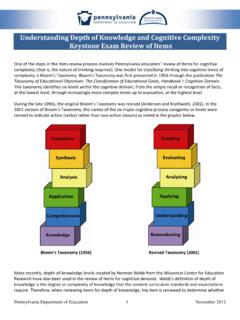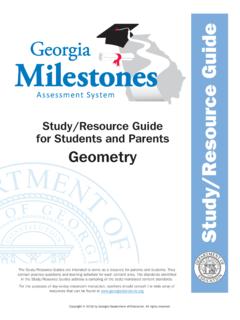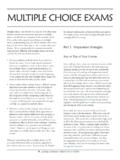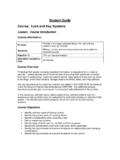Transcription of Guidelines for Critiquing and Rebutting an Expert Report
1 Www .willamette .com INSIGHTS SUMMER 2014 51 Guidelines for Critiquing and Rebutting an Expert ReportNathan P. NovakValuation Controversy InsightsThis discussion focuses on the concepts related to reviewing an opposing Expert s Report in a litigation setting. Specifically, this discussion provides a process for preparing such a rebuttal. This discussion is presented for the purpose of emphasizing the critical lens that may be applied when reviewing an opposing Expert s analysis. Five primary Guidelines are discussed: (1) understand the opposing party s argument, (2) identify contradictions, (3) avoid self-contradictions, (4) provide alternatives to areas believed to be incorrect, and (5) verify suspect research or methodologies. In addition, an example is included to provide some context and to better illustrate the the course of litigation proceedings, an Expert witness may be asked to provide a rebuttal analysis and opinion (the rebuttal) to refute the position(s) of the opposing Expert .
2 The purposes of the rebuttal are two-fold:1. To establish a solid foundation that can be used to discredit the credibility and accu-racy of the opposing Expert s position2. To further establish and support the anal-ysis, conclusions and opinions initially offeredA rebuttal can be a powerful tool when used correctly. Not only can it be used as a tool during trial, but a strong rebuttal frequently can be used as leverage for the purpose of reaching a favorable discussion provides general Guidelines that can be followed when preparing a rebuttal or review-ing a rebuttal in a litigation context. While the context is for the purpose of preparing or review-ing a rebuttal in a litigation setting, the following Guidelines are applicable when simply completing a review of another Expert s analysis and Report in a nonlitigation Rebutting an Expert analysis in a litiga-tion setting or reviewing another Expert analysis or Report , the Guidelines offered should help clarify the critical lens that one may look through when considering financial Expert opinions prepared by a qualified the oPPosing PArty s ArgumentWhile this may seem obvious, understanding the opposing party s argument is the first step in pre-paring a rebuttal.
3 An analyst cannot begin writing a critique or preparing a counter argument if he or she does not fully understand the opposing Expert s analysis and and RecreateThe first step is reading and rereading the opposing Expert s Report . The analyst should not simply read the Report the purpose of this exercise is to critically analyze the opposition s analysis. While 52 INSIGHTS SUMMER 2014 www .willamette .comreading, the analyst should view through a critical lens, focusing in on areas of weakness. It helps a great deal to read with pen and highlighter in hand, marking any areas of contradiction, questionable logic, or doubtful facts. The analyst should think of the first pass through the opposing Expert s Report as an outline to his or her own reading the opposing Expert s Report also helps to identify areas of agreement between the two sides. It is sometimes helpful to identify all the key ideas, methods, and assumptions used throughout an analysis, and then one by one com-pare them to the client s position.
4 Identifying areas of agreement from the beginning can help focus the argument and can help the valuation analyst or liti-gator identify the key areas to reading and annotating the opposing Expert s Report , it is often helpful to attempt to rec-reate the opposing Expert s analysis. This is useful for two reasons. First, this exercise can serve as a means toward identifying any calculation errors within the opposing Expert s analysis. Second, rec-reating the opposing Expert s analysis better enables the analyst to more fully understand the logic (or lack thereof) within the analysis, as well as to pre-pare for alternative scenarios, as discussed further AssumptionsWithin any analysis, there are generally two types of assumptions that an analyst may incorporate. The first type of assumption is explicit the assumptions that are directly identified and supported within the appraiser s analysis.
5 Explicit assumptions may include the estimation of the subject company s weighted-average cost of capital, the estimated long-term growth rate, or the identification of other companies in the public marketplace assumed to be similar enough to the subject company for compara-tive second type of assumption is implicit. Implicit assumptions are embedded within an analysis, and may not even be mentioned anywhere within an analysis. An implicit assumption is one that may not be directly identified, but still should be true based on various conclusions presented throughout an example, let s assume that the analyst esti-mated the market value of equity for a company at $100 million based on a discounted cash flow model. However, the subject company reported only $3 million in earnings over the latest 12-month period. This implies a price-to-earnings multiple of over 30 times for the subject reasonableness of this implied assumption may be checked by comparing it with industry price-to-earnings multiples, and/or price-to-earnings multiples for reasonably comparable publicly traded companies.
6 The reasonableness of the implied profit margin ( , earnings to revenue ratio) for the subject company may be checked through similar , the implied price-to-earnings multiple may seem too high, and it is possible the analyst may have overestimated value. However, there may be a good reason for the high multiple, such as a subject company that is relatively young with great growth prospects and a new management team with an excellent historical track , step one is to test implicit assump-tions that are based on various conclusions through-out an analysis ( , implied multiples, implied rates of return, etc.) and see if they make intuitive sense. If the assumptions do not make sense, then step two is to check and see if there is a good expla-nation or context for any seemingly unreasonable assumptions. If there appears to be no reasonable explanation for a seemingly unreasonable implicit assumption, then it may be the case that the analyst erred somewhere within his or her contrAdictionsOne of the strongest rebuttal arguments (aside from factual or calculation errors) is that the opposing Expert contradicted himself or herself within the analysis.
7 Identifying contradictions, or inconsisten-cies, can help greatly in challenging the legitimacy of the opposing Expert s arguments. Contradictions can occur in several forms, including (1) inconsis-tent use of inputs, (2) inconsistent methodologies, and (3) reliance on selective .willamette .com INSIGHTS SUMMER 2014 53 Inconsistent Use of InputsOne relatively simple contradiction to identify is the inconsistent use of inputs throughout an analysis. For example, let s say the opposing Expert utilizes the risk-free rate in estimating a weighted average cost of capital for the subject company. Consistency requires that the selected risk-free rate typically should be the same everywhere else in the analysis in components that require the use of a similar risk-free analyst should focus on similar inputs that recur throughout an analysis, and identify any that seem to be used inconsistently. Of course, he or she should fully understand the analysis to ensure that any seemingly similar inputs truly should have the same value, and are not different in any MethodologiesAnother common contradiction is the inconsistent use of methodologies throughout an analysis.
8 For example, perhaps the opposing Expert uses both the guideline publicly traded company method and the guideline transactions method to complete the analysis of a food manufacturer. However, while the Expert screened companies in the food service industry when searching for guideline publicly traded companies, he screened transactions in the food distribution industry when searching for guide-line transactions. This would be a methodological inconsistency, due to the fundamentally different screening criteria analyst should focus on any areas in the analysis that seem similar enough to warrant similar methodologies. If the opposing Expert does not seem to apply parallel logic to areas that seem to warrant it, he may have contradicted on Selective QuotesPerhaps the most common contradiction is the use of selective quotes throughout a Report . Often, an analyst will quote from a well-known and respected publication to support a particular method or con-clusion.
9 Analysts will sometimes emphasize a single quote as the glue for an analysis, attempting to link all aspects of the analysis with an authoritative statement. Whenever this appears to be the case, the analyst should closely review the referenced source material to identify other statements or concepts that may contradict the conclusions devel-oped by the opposing example, the opposing Expert may cite a book that claims the capital asset pricing model is the appropriate method for estimating the cost of equity capital. However, one page later, the same book may also state that, in particular situations, a build-up model is more appropriate. The analyst should focus on any instances where the opposing Expert relies on selected quotes to establish a level of certainty with regard to any aspect of the sel F-contrAdictionsWhen preparing a rebuttal opinion, it is important to avoid contradicting the client s position and Report .
10 This is more often an issue when the rebut-tal opinion is prepared by a third-party analyst ( , not the same analyst who completed the original analysis in the submitted Report ). In such a case, since the third-party analyst did not complete the original analysis, there may be certain contested areas where he or she is in agreement with posi-tions adopted by the opposing Expert . Or, even if the original analyst is preparing the rebuttal opinion, reading the opposing Expert s Report may bring to light other issues that had not been considered dur-ing the original such a situation arises, it is generally best to refrain from commenting in written form. The purpose of the rebuttal is to critique the opposing party s analysis, not the client s analysis. Rebuttals of weaknesses in the opposing Expert s Report that represent positions also taken by the client s Expert typically should not be published in a rebuttal opinion.
